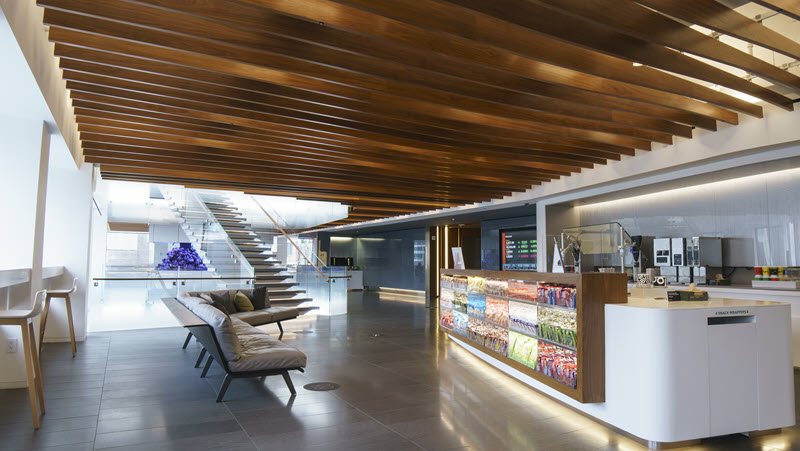Why 36 of our offices are leading with LEED and BREEAM
March 30, 2023
Michael Barry, Head of Sustainable Business Operations at Bloomberg, explains how and why we create workspaces that energize employees, promote innovation and are also eco-friendly.
Design is a core component of our culture, and so is sustainability. Every decision we make around our building design takes into consideration operational efficiency and environmental sustainability.
As of year-end 2022, Bloomberg had 36 active office spaces that are environmentally certified: 15 of our spaces have achieved LEED (Leadership in Energy and Environmental Design) Platinum (the highest rating), another 19 have achieved LEED Gold (the second highest rating), and our European headquarters has received a BREEAM rating of “Outstanding,” the system’s highest rating in both the Design and “In-Use” categories.
Buildings with LEED or BREEAM certifications have been designed and constructed to reduce energy and water usage, promote better indoor air quality and reduce the environmental impact of construction materials and waste.

The Bloomberg European Headquarters office in London, which features a “living wall,” received a BREEAM score of 98.5% – the highest design-stage score ever achieved by any major office development in the world.

Bloomberg News bureau in Budapest received LEED Platinum certification in 2014.
Our sustainable offices
Developing a large portfolio of environmentally-certified office spaces is an important component of our facilities strategy. Our first LEED project was the San Francisco Pier 3 office, which achieved LEED Gold certification in 2008. Today, over 80% of our employees work in LEED or BREEAM certified office spaces.
Read more about our sustainable practices and initiatives at Bloomberg in our 2022 Impact Report.
“We create global workplaces that our employees are proud of coming into every day. It’s not just a reflection of our commitment to minimize the firm’s environmental impact, but also a company culture that prioritizes collaboration and productivity facilitated by dynamic design,” says Paul Logan AIA, LEED AP, Global Head of Capital & Design.

Our São Paulo office is LEED Platinum certified and features open meeting areas.
The impact of a smarter, cleaner business
LEED and BREEAM certification sets high standards for sustainable building operations. Dave Wildman, Global Head of Facilities & Infrastructure explains, “Our environmentally certified offices reduce operating costs and our environmental impact, while improving the health and well-being of the occupants — fitting perfectly with our commitment to sustainability.”
For example, the bathroom and pantry fixtures we installed have reduced potable water usage by 37%, resulting in an estimated annual savings of nearly 7 million gallons of water.
 Bloomberg pantry in the 919 Third Ave New York office, our most recent LEED Gold certified building.
Bloomberg pantry in the 919 Third Ave New York office, our most recent LEED Gold certified building.
Our lighting power has been reduced by 25%, saving an estimated 12 million kWh to date — the equivalent of the annual electricity use of 1,545 homes. We also diverted 86% of total construction waste away from landfills.
On top of that, we as employees can make a difference in our communities. “Our office spaces are designed to help reduce our consumption of materials, encouraging employees to recycle and compost waste. A practice that many employees incorporate into their personal lives,” says Dave.
Third-party sustainability certifications are a prime example of a best-in-class standard being put to use at Bloomberg that makes sense for business and the community.
To find out more about our sustainability efforts view our 2022 Impact Report.
LEED (Leadership in Energy and Environmental Design) is an internationally recognized green building certification system administered by the U.S. Green Building Council.
BREEAM is a sustainability assessment method for master planning projects, infrastructure and buildings. It recognizes and reflects the value in higher performing assets across the built environment lifecycle, from new construction to in-use and refurbishment.